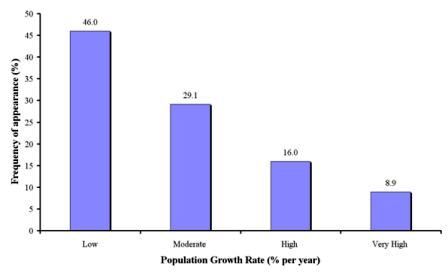Population density
Population density is an indicator closely related with the level of human pressure to natural resources and with the sensitivity of an area to land degradation and desertification. Over the last decades the Mediterranean countries have experienced a tremendous increase of population. In 2000 the whole 22 riparian countries had 428 million people compared to 285 million in 1970. The population density is quite different between northern and southern countries with the latest having an annual growth rate of 2.35% per year or an increase of 3.9 million people per year for all the countries from Morocco to Turkey. These numbers are five times higher than the northern Mediterranean countries.
Population density has been defined as the ratio between (total) population and surface (land) area in which this population exists. This ratio has been calculated for the different territorial units in each study site, for any point in time, depending on the source of the population data. An alternative definition for population density is the number of persons per unit of area, which may include or exclude cultivated or potentially productive area. The following equation has been used for calculation of population density (PD) (source: http://en.wikipedia.org/wiki/Population_density):

The following classes have been defined for this project: (a) low- PD< 50 people/km2), (b) moderate- PD=50-100 people/km2), (c) high-PD=100-300 people/km2, and (d) very high-PD>300 people/ km2.
As Table 14 shows, this indicator has been defined in 1408 field sites, corresponding to 15 study sites. The analysis of the data have shown low population density is the prevailing class, covering 61.4% of the study field sites (Fig. 96). Such population density has been defined in all cases of the study sites of Boteti Area-Botswana, Gois-Portugal, Djanybek-Russia, Secano Interior-Chile, Guadalentin Basin Murcia-Spain, Zeuss Koutine-Tunisia, Eskisehir-Turkey, Nestos Basin Maggana-Greece, Konya Karapinar plain-Turkey, and Mação- Portugal, and in some field sites of Crete-Greece, Cointzio Catchment-Mexico, and Novij Saratov-Russia. Moderate population density (PD=50-100 people/km2) has been defined in 32.5% of the study field sites, corresponding to the study sites Novij Saratov-Russia, Santiago Island-Cape Verde, Mamora Sehoul-Morocco, Cointzio Catchment-Mexico, and Crete-Greece. High population density (PD=100-300 people/km2) has been described in 6.1% of the study field sites, corresponding to the study site of Santiago Island-Cape Verde (Fig. 96).

Fig. 96. Distribution of population density classes defined in the study sites